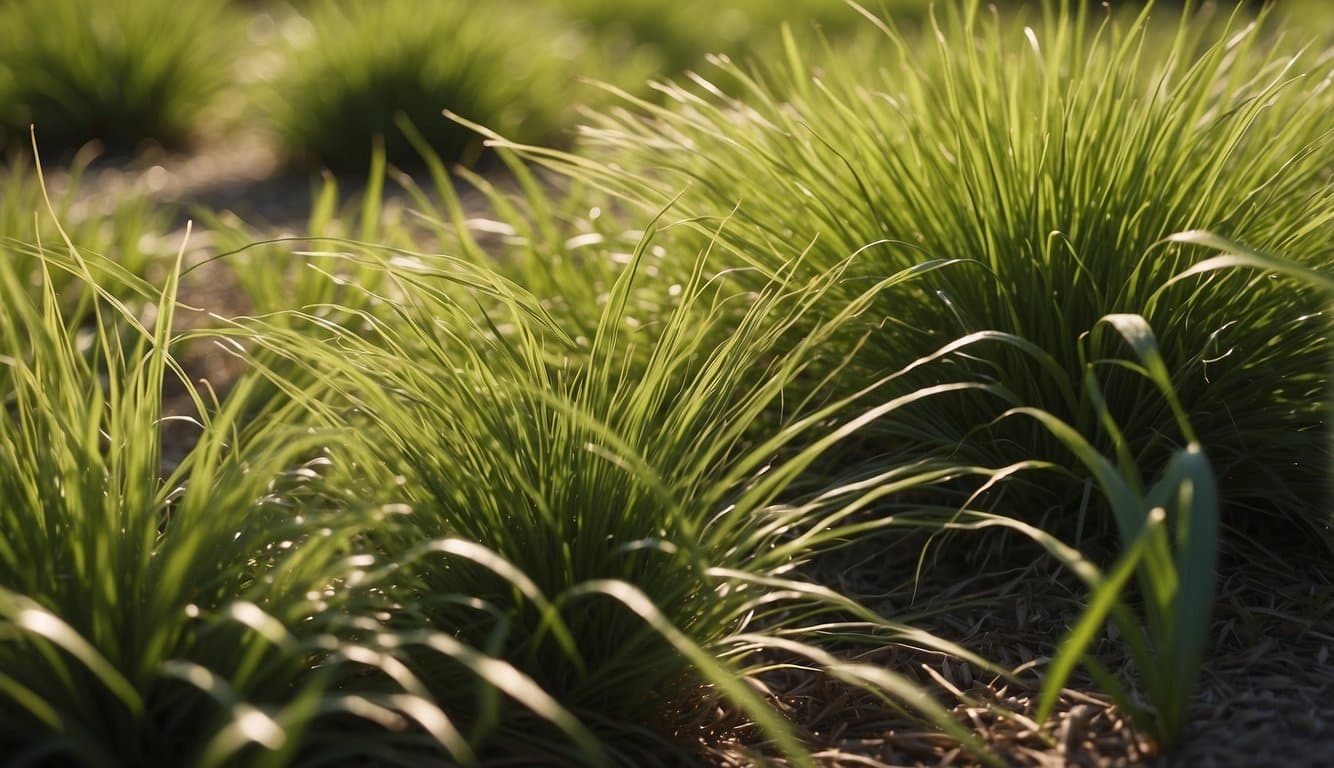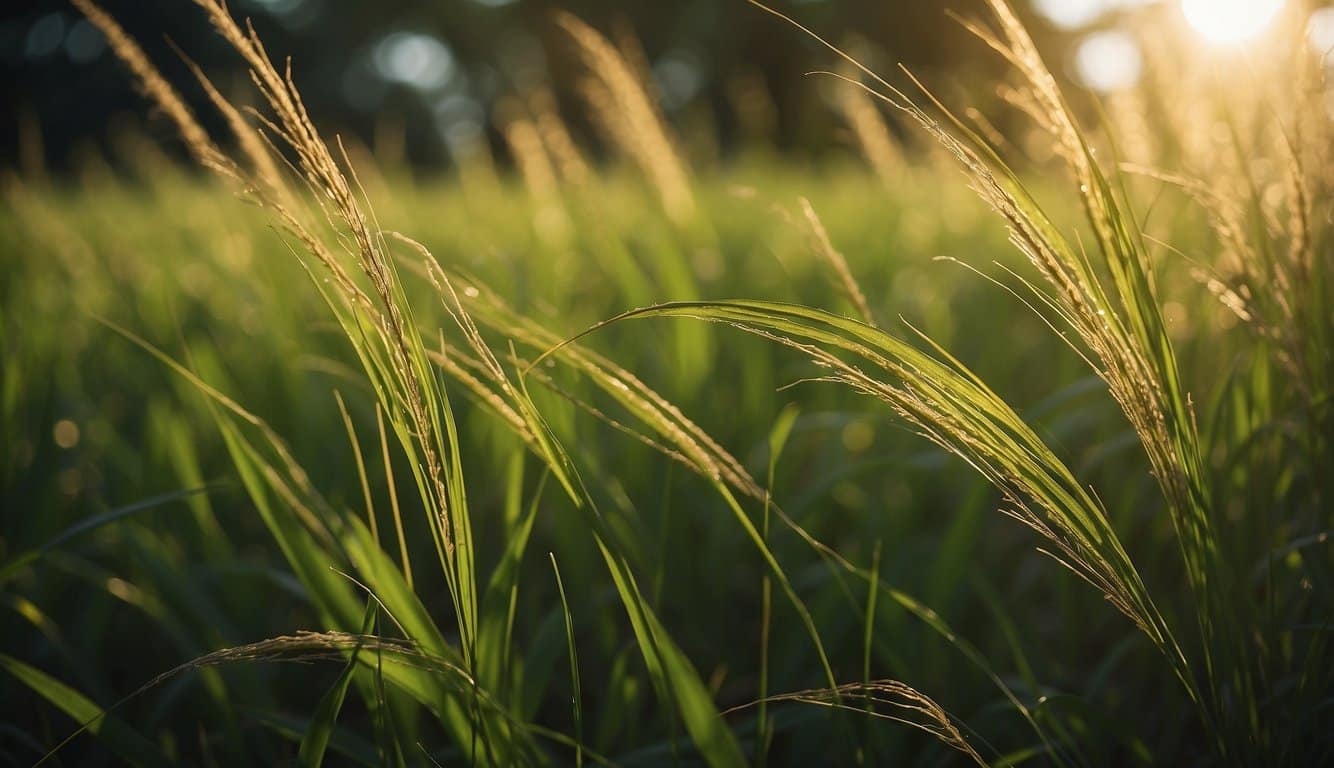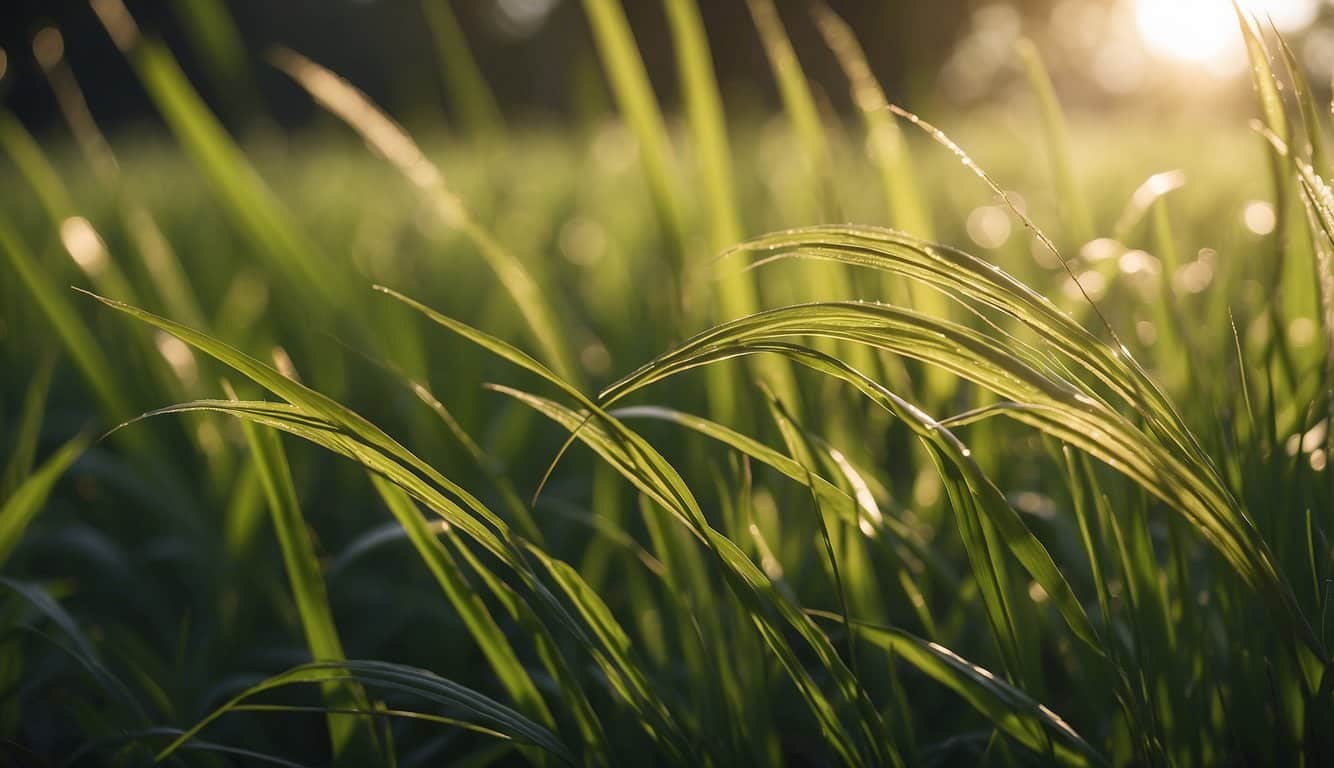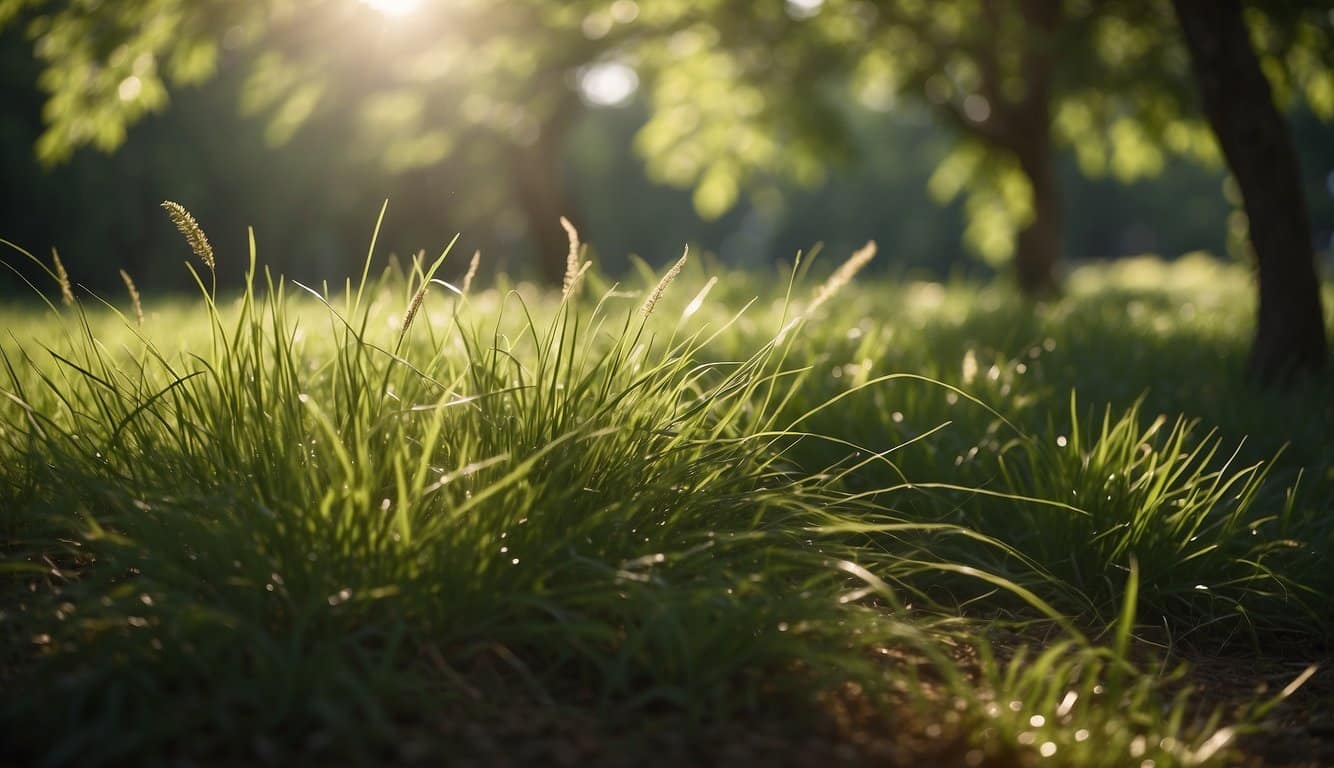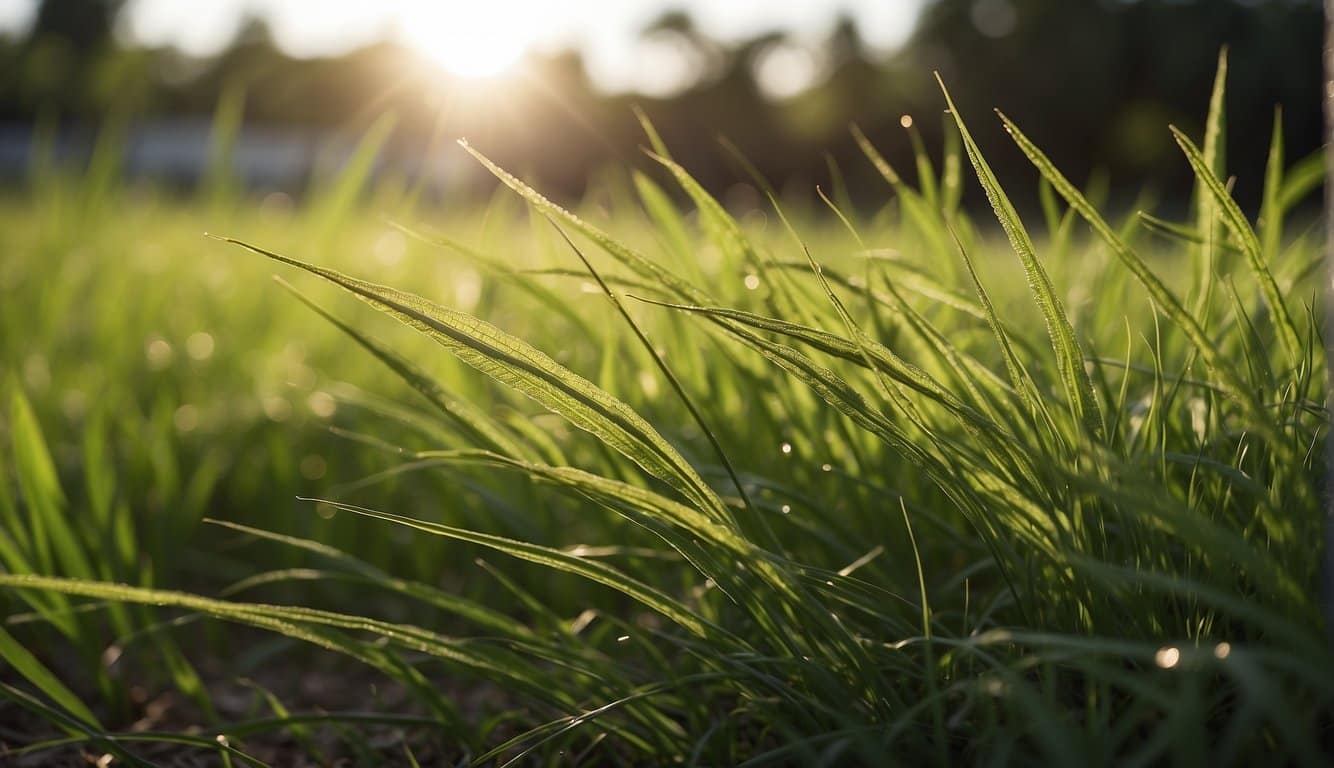Florida’s climate provides an ideal environment for a diversity of grass species suitable for lawns. These species thrive due to the state’s subtropical warmth and frequent sunshine.
St. Augustine grass is perhaps the most common, appreciated for its robustness and ability to create dense, carpet-like lawns. With broad, flat blades, it exhibits a rich blue-green hue.
Here is a list of grass types that perform well across Florida’s landscapes:
- Bermuda Grass: Known for its fine texture and rapid growth, this grass is commonly found on sports fields and golf courses. It prefers full sun and is revered for its tolerance to foot traffic and drought.
- Zoysia Grass: Distinguished by its fine texture and deep green color, Zoysia is quite versatile, doing well in both sun and light shade.
- Centipede Grass: This grass requires minimal maintenance and mowing. It grows slowly and has a medium texture, though it’s less tolerant of heavy foot traffic.
- Buffalo Grass: Praised for its drought tolerance, this species exhibits a fine texture and a soft, inviting look.
When choosing among these grasses, homeowners should consider factors such as sun exposure, expected foot traffic, and maintenance preferences.
Each of these grasses has its specific ideal mowing height and care routine, which must be adhered to for optimal lawn health and appearance.
Warm-Season Grasses that Thrive in FL
Florida’s climate favors warm-season grasses, which are characterized by their resilience to heat and humidity. These grasses also have a higher tolerance for drought and can endure the subtropical conditions prevalent across the state. The following types are particularly well-suited for Florida lawns.
Bermuda Grass
Bermuda Grass is robust and able to withstand heavy foot traffic, making it an ideal choice for sports fields and golf courses. It has deep roots which allow it to access moisture during dry periods.
St. Augustine Grass
St. Augustine Grass is a staple in Florida lawns due to its thick blades forming a dense lawn. This grass type excels in both shade and sun, and it has a remarkable tolerance to salty conditions, which is perfect for coastal areas.
Zoysia Grass
Zoysia Grass is prized for its fine texture and deep green color. It is relatively slow-growing but creates a lush, thick turf resistant to weeds. Zoysia adapts well to various soil types and is known for its durability.
Bahia Grass
Bahia Grass requires minimal maintenance and is esteemed for its ability to thrive in less fertile, sandy soils. It is drought-resistant and often used in areas that are difficult to irrigate.
Centipede Grass
Centipede Grass is a low-maintenance variety that does well in acidic soils common in Florida. It is slow-growing, which reduces the need for frequent mowing, and it has a light green color that is unique among lawn grasses.
Cool-Season Grasses that Thrive in FL
While warm-season grasses are commonly favored for Florida’s subtropical climate, there are certain cool-season grasses that can perform well during the state’s milder winters. Homeowners seeking a verdant lawn year-round may consider these options.
Rye Grass
Rye grass is a temporary solution in Florida for achieving a green lawn during cooler months. It germinates quickly and is often used for overseeding dormant warm-season grasses.
- Germination Time: Swift, usually within 5 to 10 days.
- Climate Tolerance: Prefers cooler temperatures and can struggle in the Florida heat.
Kentucky Bluegrass
Kentucky Bluegrass, while more challenging to maintain in Florida, can be successful, particularly in the northern regions of the state.
- Texture: Fine, with a soft and lush appearance.
- Soil Preference: Requires well-drained, fertile soil and consistent moisture.
Shade Tolerant Grasses
When it comes to cultivating a lush Florida lawn in low-light conditions, the selection of shade tolerant grasses is paramount. Though the state is known for its sunshine, many lawns have shaded areas where certain grasses can thrive better than others.
Fine Fescue
Fine fescue grasses are valued for their ability to prosper in less sunny areas. They are a suitable choice for lawns with partial shade, as they can tolerate as little as four hours of direct sunlight per day. Here are key characteristics:
- Shade Tolerance: 4-6 hours of sun daily
- Maintenance: Low, with less frequent mowing needs
- Soil Preference: Adaptable to a range of soil types, including poor soils
Shade-Tolerant St. Augustine
St. Augustine grass is a robust, shade-tolerant species well-suited to Florida’s subtropical climate. It especially thrives in residential and commercial areas. Specifics to note:
- Shade Tolerance: Performs well with three to four hours of sun exposure
- Growth Habits: Develops a thick, carpet-like lawn with coarse blades
- Strengths: Exceptional shade tolerance and durability in warm, humid conditions
Drought-Resistant Varieties
Florida’s climate presents unique challenges for lawn care, particularly in selecting grasses that can thrive during dry spells. Homeowners and landscapers prefer varieties that maintain their vigor and green appearance, even under water restrictions. Here are some of the top drought-resistant grasses for Florida lawns:
- Buffalo Grass: With its gray-green to bluish-green leaves, buffalo grass stands out as a hardy option. Its thin and spindly blades grow to a height of between 2 and 5 inches, and the species is both drought- and cold-resistant, making it well-suited for Florida’s varying conditions. It’s recognized for creating a thick, robust lawn.
- Zoysia Grass: Experts often recommend Zoysia for its incredible durability, drought tolerance, and ability to withstand heavy foot traffic. It shines in full sun environments and offers resistance to disease and pests, capping off its profile as a highly reliable choice for Florida lawns.
- St. Augustine Grass: A common sight across Florida, St. Augustine grass thrives in both residential and commercial spaces. This type can adapt to a range of green shades and prefers moderate traffic. While it enjoys dappled shade, St. Augustine grass demands more water during extended dry periods but remains a steadfast option.
- Bermuda Grass: This grass boasts several drought-tolerant cultivars, including Common Bermuda and Tifway 419. Bermuda grass generally needs a sunny environment and exhibits resilience to drought. It’s also known for staying green during the winter months.
| Grass Type | Blade Color | Height | Shade Tolerance | Traffic Resistance | Additional Benefits |
|---|---|---|---|---|---|
| Buffalo Grass | Gray-green/Bluish | 2″-5″ | Low | Moderate | Cold-resistant |
| Zoysia Grass | Varies | 1″-3″ | Moderate | High | Disease and pest resistance |
| St. Augustine | Light to dark green | 2.5″-3″ | Moderate | Moderate | Resilient, common in FL |
| Bermuda Grass | Green | 0.5″-2″ | Low | High | Winter green |
Grass Care and Maintenance
Maintaining a beautiful lawn in Florida requires understanding the specific needs of the grass types suited to this region.
Regular care involves several critical practices to ensure the lawn stays healthy, vibrant, and able to withstand Florida’s unique climate challenges.
Homeowners must adopt a consistent routine that includes watering, mowing, fertilization, and pest control.
Watering: Grass in Florida thrives on a consistent watering schedule.
It’s recommended to water lawns deeply but infrequently to encourage deep root growth.
The best time for watering is early in the morning to minimize evaporation and fungal growth.
- Warm-season grasses: 1-1.5 inches of water per week.
- Cool-season grasses: 1 inch of water per week during active growth periods.
Mowing: Different grass types have optimal mowing heights for health and growth.
Mowing too short can stress the grass and make it susceptible to weeds and diseases.
- St. Augustine: 2.5-4 inches
- Bermuda: 1-2 inches
- Centipede: 1.5-2.5 inches
- Zoysia: 1-2.5 inches
Fertilization: Apply the right fertilizer for your grass type and soil conditions, ideally during the growing season.
Over-fertilization can lead to excessive growth, nutrient runoff, and potential environmental harm.
- Frequency: Two to four times per year, based on the grass type and soil testing results.
Pest Control: Florida lawns are susceptible to various pests and diseases.
Regular monitoring and proper identification help in timely and effective treatment.
- Common pests: Chinch bugs, grubs, and mole crickets.
- Disease management: Fungicide applications may be necessary during humid and wet conditions.
Frequently Asked Questions
When selecting a type of grass for a Florida lawn, homeowners typically look for options that can withstand the state’s warm, humid climate and sandy soil. The following are common inquiries regarding grass selection for Florida landscapes.
Which species of grass are most suitable for the Florida climate?
Warm-season grasses thrive in Florida due to its subtropical climate.
St. Augustine grass is particularly favored for its thick blades and resilient nature, creating a dense carpet-like lawn that copes well with the humidity and warmth.
How does Bermuda grass perform in Florida’s weather conditions?
Bermuda grass is known for its fine texture and aggressive growth, making it a popular choice for Florida lawns.
It excels in full sun and high temperatures but requires more maintenance to keep it in check.
What are the ideal grass choices for lawns with sandy soil in Florida?
Grasses like Bahia and Bermuda are preferred for sandy soils commonly found in Florida.
These varieties establish deep root systems, which help them remain robust in less fertile conditions.
What is the most low-maintenance grass option for Florida homeowners?
Bahia grass stands out as a low-maintenance option.
It’s drought-resistant, can thrive in less fertile soil, and generally requires less watering and fertilization than other types.
Are Bahia grass varieties well-adapted to Florida lawns?
Yes, Bahia grass varieties are well-suited to the Florida environment.
They are known for their drought tolerance and ability to grow in sandy, acidic soils, which are prevalent in the state.
What are the differences between Zoysia and St. Augustine grasses for use in Florida?
Zoysia grass is valued for its tolerance to foot traffic and its relatively slow growth. This reduces the need for frequent mowing.
St. Augustine grass, on the other hand, grows quickly and has a plush appearance but can require more upkeep. Both are viable for Florida lawns but offer different aesthetic and maintenance levels.
Last update on 2025-06-06 / Affiliate links / Images from Amazon Product Advertising API
